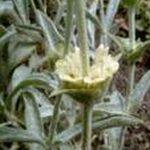| Common Name: |
Tsailopita |
| Other Names: |
Greek Mountain Tea, Tsai |
| Botanical Name: |
Sideritis syriaca |
| Genus: |
Sideritis |
| Family: |
Lamiaceae |
| Native Location: |
S Greece and Crete |
| Cultivation: |
Well-drained, gritty or stony soil in full sun. Provide a dry position or mulch with grit in winter to prevent excessive moisture and mud splashing. |
| Propagation: |
By seed sown in spring; by semi-ripe cuttings in summer; by division in spring. |
| Harvest: |
Leaves are collected in spring, flowering tops as the first flowers open, and dried for infusion. |
| Height: |
50cm (20in) |
| Width: |
50cm (20in) |
| Hardiness: |
Z8 |
| Parts Used: |
Leaves, flowering tops. |
| Properties: |
An aromatic digestive herb. |
| Culinary Uses: |
Dried leaves and flowering tops are made into tea. |
| Bibliography: |
Encyclopedia of Herbs by Deni Brown Copyright © 1995, 2001 Dorling Kindersley Limited. pg 368 |

